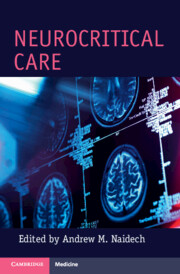Book contents
- Neurocritical Care
- Neurocritical Care
- Copyright page
- Contents
- Contributors
- 1 Introduction
- 2 Intracranial Pressure Monitoring and Management
- 3 Disorders of Temperature Regulation
- 4 Approach to Neuroimaging of the Brain, Vessels, and Cerebral Edema
- 5 Airway and Ventilator Management of the Neurologically Critically Ill Patient
- 6 Neurocritical Care Pharmacology
- 7 Intracerebral Hemorrhage
- 8 Correction of Coagulopathy
- 9 Subarachnoid Hemorrhage
- 10 Subdural Hematoma
- 11 Critical Care Management of Neurotrauma
- 12 Critical Care Management before and after Open and Intravascular Procedures
- 13 Shared Decision-Making in the Neuro-ICU
- 14 Status Epilepticus and EEG Monitoring
- 15 Evaluation of the Comatose Patient and Overview of the Brain Death Examination
- Index
- References
11 - Critical Care Management of Neurotrauma
Published online by Cambridge University Press: 19 May 2022
- Neurocritical Care
- Neurocritical Care
- Copyright page
- Contents
- Contributors
- 1 Introduction
- 2 Intracranial Pressure Monitoring and Management
- 3 Disorders of Temperature Regulation
- 4 Approach to Neuroimaging of the Brain, Vessels, and Cerebral Edema
- 5 Airway and Ventilator Management of the Neurologically Critically Ill Patient
- 6 Neurocritical Care Pharmacology
- 7 Intracerebral Hemorrhage
- 8 Correction of Coagulopathy
- 9 Subarachnoid Hemorrhage
- 10 Subdural Hematoma
- 11 Critical Care Management of Neurotrauma
- 12 Critical Care Management before and after Open and Intravascular Procedures
- 13 Shared Decision-Making in the Neuro-ICU
- 14 Status Epilepticus and EEG Monitoring
- 15 Evaluation of the Comatose Patient and Overview of the Brain Death Examination
- Index
- References
Summary
The critical care management of neurotrauma patients is very complex, requiring a strong knowledge base in both neurology and trauma surgery. This chapter is designed as a bridge for healthcare providers from different specialties, including residents and fellows, hospitalists, ICU physicians, and advanced practice providers seeing patients with neurotrauma in an intensive care unit setting, to be more familiar managing common issues encountered in this patient population. The chapter addresses core knowledge in trauma surgery, such as the ABCDE approach in trauma assessment, cervical spine management, hemorrhagic shock, the reversal of anticoagulants, chest tube management, abdominal and extremity compartment syndrome, and burn. The chapter also offers introductory comments about head injury, management of traumatic brain injury (TBI), intracranial hemorrhage (ICH), and intracranial pressure (ICP).
- Type
- Chapter
- Information
- Neurocritical Care , pp. 196 - 226Publisher: Cambridge University PressPrint publication year: 2022



